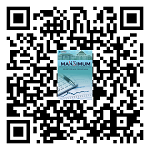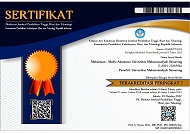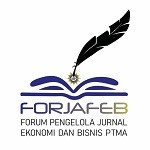Pencapaian Target Sustainable Development Goals dengan Konsep Material Flow Cost Accounting
(1) Universitas Trilogi
(2) Universitas Trilogi
(*) Corresponding Author
Abstract
Full Text:
PDFReferences
Asian Productivity Organization. (2014). Manual on Material Flow Cost Accounting: ISO 14051 (I. Expressions (ED.). Hirakawa Kogyosha Co., Ltd., Japan.
Badan Perencanaan Pembangunan Nasional (BAPPENAS). (2017). Lembar Fakta SDGs.
Furukawa, Y. (2013). Material Flow Cost Accounting.
Hyrslova, J., Vagner, M., & Palasek, J. (2011). Material Flow Cost Accounting (MFCA) – Tool for the Optimization of Corporate Production Processes. Business, Management and Education, 9(1), 5–18. https://doi.org/10.3846/bme.2011.01
Kasemset, C., Boonmee, C., & Khuntaporn, P. (2016). Application of MFCA and ECRS in waste reduction: A case study of electronic parts factory. Proceedings of the International Conference on Industrial Engineering and Operations Management, 8-10 March (March 2016), 1844–1853.
Kementerian Perencanaan Pembangunan Nasional/Badan Perencanaan Pembangunan Nasional (BAPPENAS). (2017). Metadata indikator Tujuan Pembangunan Berkelanjutan.
Kurniati, E., Haji, A. T. S., & Renaningtya, A. P. (2019). Environmental Management Accounting (EMA) Pada Unit Urea Pt Petrokimia Gresik Environmental Management Accounting (EMA) On Urea Unit PT Petrokimia Gresik. Environmental Management Accounting (EMA) Pada Unit Urea Pt Petrokimia Gresik, 5(3), 15–20.
Linnenluecke, M. K., & Griffiths, A. (2010). Corporate sustainability and organizational culture. Journal of World Business, 45(4), 357–366.
https://doi.org/10.1016/j.jwb.2009.08.006
Loen, M. (2018). Penerapan Green Accounting Dan Material Flow Cost Accounting (MFCA) Terhadap Sustainable Development. Jurnal Akuntansi Dan Bisnis Krisnadwipayana, 5(1), 1–14. https://doi.org/10.35137/jabk.v5i1.182
Marián Gogola, Daniela Durcanska, Marta Hocova, Iveta Kubasakova, Manuela Ingaldi, Dorota Klimecka Tatar, Vladimir Permyakov, Vitaly Parfenov, Sergei Alexandrov, Yuri Sivkov, A. N. (2016). Environmental management & audit : Tempus project Recoaud. 4, Environmental assessment - featured articles. In Scientific Publishing Hub. http://sphub.org/books/eu-tempus-recoaud-environmental-assesment/
Marota, R., Marimin, M., & Sasongko, H. (2004). Perancangan Dan Penerapan Material Flow Cost Accounting Untuk Peningkatan Keberlanjutan Perusahaan Pt XYZ. Jurnal Manajemen Dan Agribisnis, 12(2), 92–105. https://doi.org/10.17358/jma.12.2.92
Material Flow Cost Accounting MFCA Case Examples, (2010).
Mukarrom, A. (2014). Sejarah Islam Indonesia I: Dari Awal Islamisasi Sampai Periode Kerajaan-Kerajaan Islam Nusantara. Surabaya: IAIN Press.
Nakajima, M. (2006). The New Management Accounting Field Established by Material Flow Cost Accounting (MFCA).
Nakajima, M. (2009). Evolution of Material Flow Cost Accounting (MFCA): Characteristics on development of MFCA Companies and Significance of Relevance of MFCA. 27–46.
National Statistical Office. (2014). A Study of Sustainable Development Goals (SDGs) Indicators.
Ngoyo, M. F. (2015). Mengawal Sustainable Development Goals (SDGs); Meluruskan Orientasi Pembangunan yang Berkeadilan. Sosio Religius, I (1), 77–88.
Perencanaan, K., & Nasional, P. (2017). Pedoman penyusunan rencana aksi.
Rimantho, D., Noor, E., Eriyatno, E., & Effendi, H. (2019). Penilaian aliran limbah elektronika di DKI Jakarta menggunakan Material Flow Analysis (MFA). Jurnal Ilmu Lingkungan, 17(1), 120. https://doi.org/10.14710/jil.17.1.120-129
Schmidt, M., & Nakajima, M. (2013). Material flow cost accounting as an approach to improve resource efficiency in manufacturing companies. Resources, 2(3), 358–369. https://doi.org/10.3390/resources2030358
Sugiyono. (2016). Metode Penelitian dan Pengembangan (Research and Development/R&D). Alfabeta CV.
Syarif, A. M., & Novita, N. (2019). Environmental Management Accounting with Material Flow Cost Accounting: Strategy of Environmental Management in Small and Medium-sized Enterprises Production Activities. Indonesian Management and Accounting Research, 17(2), 143. https://doi.org/10.25105/imar.v17i2.5313
Sygulla, R., Bierer, A., & Gotze, U. (2011). Material Flow Cost Accounting-Proposals for Improving the Evaluation of Monetary Effects of Resource Saving Process Designs. 44th CIRP International Conference on Manufacturing Systems, June, 1–3.
Article Metrics
Abstract view : 494 timesPDF - 0 times
DOI: https://doi.org/10.26714/mki.11.1.2021.27-42
Refbacks
-----------------------------------------------------------------------------------------------------------------------------------------------------------------------------------
 | MAKSIMUM: Media Akuntansi Universitas Muhammadiyah Semarang |
![]()
Maksimum: Media Akuntansi Universitas Muhammadiyah Semarang is licensed under a Creative Commons Attribution Attribution-NonCommercial-NoDerivatives 4.0 International License.

















